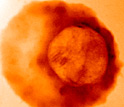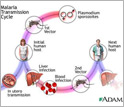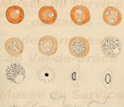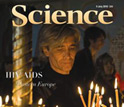News Release 10-117
Setting a Molecular Clock for Malaria Parasites
Evolutionary timeline determined for malaria parasites in mammals, birds, reptiles
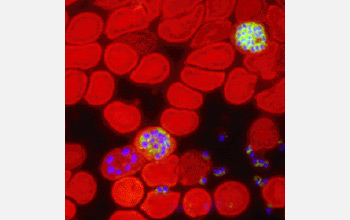
Malaria parasites inside: red blood cells infected with malaria parasites (cell nucleus in blue).
July 8, 2010
This material is available primarily for archival purposes. Telephone numbers or other contact information may be out of date; please see current contact information at media contacts.
Scientists have determined the evolutionary timeline for the microscopic parasites that cause one of the world's most widespread infectious diseases: malaria.
Having an understanding of the origins of the lineages of such pathogens, or disease-causing organisms, is fundamental to understanding emerging diseases, according to the researchers.
The origin of malaria in humans has been dated to as recent as 10,000 years ago and as long as several million years ago.
Now biologists Robert Ricklefs of the University of Missouri-St. Louis and Diana Outlaw of Mississippi State University in Starkville have found a molecular clock for malaria parasites that provides a more precise date.
The results of their research, funded by the National Science Foundation (NSF), appear in this week's issue of the journal Science.
The findings provide a well-supported time calibration for the evolution of malaria parasites.
By marrying DNA research with a new statistical approach, the biologists were able to get a better handle on the timeline of parasite evolution.
The scientists found that a key gene in malaria parasites evolved at 60 percent of the rate of the same gene in its hosts.
Knowing the rate of gene evolution of the vertebrate hosts, the biologists were able to estimate that modern malaria parasites began to diversify across mammals, birds and reptiles about 16 million years ago.
The ancestors of humans acquired the parasite 2.5 million years ago.
"Malaria parasites undoubtedly were relatively benign for most of that history, becoming a major disease only after the origins of agriculture and dense human populations," said Ricklefs.
"These findings are important in providing a quantitative rate of evolution for malaria," said Alan Tessier, program director in NSF's Division of Environmental Biology, which funded the research.
"They also reveal that host-switching can result in a rapid diversification of parasites, and decouple their evolution from that of their hosts," Tessier said.
"Because single-celled malaria parasites leave no fossil record, one has to estimate their rate of evolution by comparison with their hosts," said Ricklefs.
"Previously, this had been done under the assumption that parasites evolve at the same rate as their hosts and thus were the same age as their hosts."
Ricklefs and Outlaw's research suggests that the parasites may jump to new, unrelated hosts at any time.
"One cannot equate parasite evolution," said Ricklefs, "with a host's evolution."
-NSF-
-
Malaria parasite within a human red blood cell: where the disease begins
Credit and Larger Version -
Malaria in humans starts with the bite of a mosquito infected with a malaria-carrying parasite.
Credit and Larger Version -
An 1800s sketch by Alphonse Laveran, the French doctor who identified the malaria parasite.
Credit and Larger Version -
The researchers' findings are described in the July 9, 2010 issue of the journal Science.
Credit and Larger Version
Media Contacts
Cheryl Dybas, NSF, (703) 292-7734, email: cdybas@nsf.gov
Kylie Shafferkoetter, UMSL, (314) 516-5851, email: shafferkoetterk@umsl.edu
The U.S. National Science Foundation propels the nation forward by advancing fundamental research in all fields of science and engineering. NSF supports research and people by providing facilities, instruments and funding to support their ingenuity and sustain the U.S. as a global leader in research and innovation. With a fiscal year 2023 budget of $9.5 billion, NSF funds reach all 50 states through grants to nearly 2,000 colleges, universities and institutions. Each year, NSF receives more than 40,000 competitive proposals and makes about 11,000 new awards. Those awards include support for cooperative research with industry, Arctic and Antarctic research and operations, and U.S. participation in international scientific efforts.
Connect with us online
NSF website: nsf.gov
NSF News: nsf.gov/news
For News Media: nsf.gov/news/newsroom
Statistics: nsf.gov/statistics/
Awards database: nsf.gov/awardsearch/
Follow us on social
Twitter: twitter.com/NSF
Facebook: facebook.com/US.NSF
Instagram: instagram.com/nsfgov



